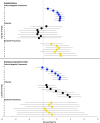The Association between Respiratory Infection and Air Pollution in the Setting of Air Quality Policy and Economic Change
- PMID: 30398895
- PMCID: PMC6394122
- DOI: 10.1513/AnnalsATS.201810-691OC
The Association between Respiratory Infection and Air Pollution in the Setting of Air Quality Policy and Economic Change
Abstract
Rationale: Fine particulate matter air pollution of 2.5 μm or less in diameter (PM2.5) has been associated with an increased risk of respiratory disease, but assessments of specific respiratory infections in adults are lacking.
Objectives: To estimate the rate of respiratory infection healthcare encounters in adults associated with acute increases in PM2.5 concentrations.
Methods: Using case-crossover methods, we studied 498,118 adult New York State residents with a primary diagnosis of influenza, bacterial pneumonia, or culture-negative pneumonia upon hospitalization or emergency department (ED) visit (2005-2016). We estimated the relative rate of healthcare encounters associated with increases in PM2.5 in the previous 1-7 days and explored differences before (2005-2007), during (2008-2013), and after (2014-2016) implementation of air quality policies and economic changes.
Results: Interquartile range increases in PM2.5 over the previous 7 days were associated with increased excess rates (ERs) of culture-negative pneumonia hospitalizations (2.5%; 95% confidence interval [CI], 1.7-3.2%) and ED visits (2.5%; 95% CI, 1.4-3.6%), and increased ERs of influenza ED visits (3.9%; 95% CI, 2.1-5.6%). Bacterial pneumonia hospitalizations, but not ED visits, were associated with increases in PM2.5 and, though imprecise, were of a similar magnitude to culture-negative pneumonia (Lag Day 6 ER, 2.3%; 95% CI, 0.3-4.3). Increased relative rates of influenza ED visits and culture-negative pneumonia hospitalizations were generally larger in the "after" period (P < 0.025 for both outcomes), compared with the "during" period, despite reductions in overall PM2.5 concentrations.
Conclusions: Increased rates of culture-negative pneumonia and influenza were associated with increased PM2.5 concentrations during the previous week, which persisted despite reductions in PM2.5 from air quality policies and economic changes. Though unexplained, this temporal variation may reflect altered toxicity of different PM2.5 mixtures or increased pathogen virulence.
Keywords: air pollution; bacterial pneumonia; influenza virus; particulate matter.
Figures



Similar articles
-
Comparison of the rate of healthcare encounters for influenza from source-specific PM2.5 before and after tier 3 vehicle standards in New York state.J Expo Sci Environ Epidemiol. 2025 Apr;35(2):205-213. doi: 10.1038/s41370-024-00710-w. Epub 2024 Aug 10. J Expo Sci Environ Epidemiol. 2025. PMID: 39127830 Free PMC article.
-
PM2.5 and its components and respiratory disease healthcare encounters - Unanticipated increased exposure-response relationships in recent years after environmental policies.Environ Pollut. 2024 Nov 1;360:124585. doi: 10.1016/j.envpol.2024.124585. Epub 2024 Jul 20. Environ Pollut. 2024. PMID: 39038774
-
Associations between Source-Specific Particulate Matter and Respiratory Infections in New York State Adults.Environ Sci Technol. 2020 Jan 21;54(2):975-984. doi: 10.1021/acs.est.9b04295. Epub 2019 Dec 18. Environ Sci Technol. 2020. PMID: 31755707 Free PMC article.
-
Respiratory Health Effects of Air Pollutants.Immunol Allergy Clin North Am. 2024 Feb;44(1):15-33. doi: 10.1016/j.iac.2023.07.004. Epub 2023 Sep 7. Immunol Allergy Clin North Am. 2024. PMID: 37973257 Review.
-
Fine particulate matter manipulates immune response to exacerbate microbial pathogenesis in the respiratory tract.Eur Respir Rev. 2024 Sep 4;33(173):230259. doi: 10.1183/16000617.0259-2023. Print 2024 Jul. Eur Respir Rev. 2024. PMID: 39231594 Free PMC article. Review.
Cited by
-
The short-term effects of air pollutants on influenza-like illness in Jinan, China.BMC Public Health. 2019 Oct 21;19(1):1319. doi: 10.1186/s12889-019-7607-2. BMC Public Health. 2019. PMID: 31638933 Free PMC article.
-
Risk Factors for Respiratory Viral Infections: A Spotlight on Climate Change and Air Pollution.J Asthma Allergy. 2023 Jan 25;16:183-194. doi: 10.2147/JAA.S364845. eCollection 2023. J Asthma Allergy. 2023. PMID: 36721739 Free PMC article. Review.
-
The Impact of the Lockdown Caused by the COVID-19 Pandemic on the Fine Particulate Matter (PM2.5) Air Pollution: The Greek Paradigm.Int J Environ Res Public Health. 2021 Jun 23;18(13):6748. doi: 10.3390/ijerph18136748. Int J Environ Res Public Health. 2021. PMID: 34201596 Free PMC article.
-
Acute Effects of Ambient Air Pollution on Asthma Emergency Department Visits in Ten U.S. States.Environ Health Perspect. 2023 Apr;131(4):47003. doi: 10.1289/EHP11661. Epub 2023 Apr 3. Environ Health Perspect. 2023. PMID: 37011135 Free PMC article.
-
Ambient air pollution and risk of respiratory infection among adults: evidence from the multiethnic study of atherosclerosis (MESA).BMJ Open Respir Res. 2021 Mar;8(1):e000866. doi: 10.1136/bmjresp-2020-000866. BMJ Open Respir Res. 2021. PMID: 33664125 Free PMC article.
References
-
- Xu J, Kochanek KD, Murphy SL, Arias E. Mortality in the United States, 2012. NCHS Data Brief. 2014;(168):1–8. - PubMed
-
- Pope CA, III, Dockery DW. Health effects of fine particulate air pollution: lines that connect. J Air Waste Manag Assoc. 2006;56:709–742. - PubMed
-
- Ciencewicki J, Jaspers I. Air pollution and respiratory viral infection. Inhal Toxicol. 2007;19:1135–1146. - PubMed
Publication types
MeSH terms
Substances
Grants and funding
LinkOut - more resources
Full Text Sources
Medical

